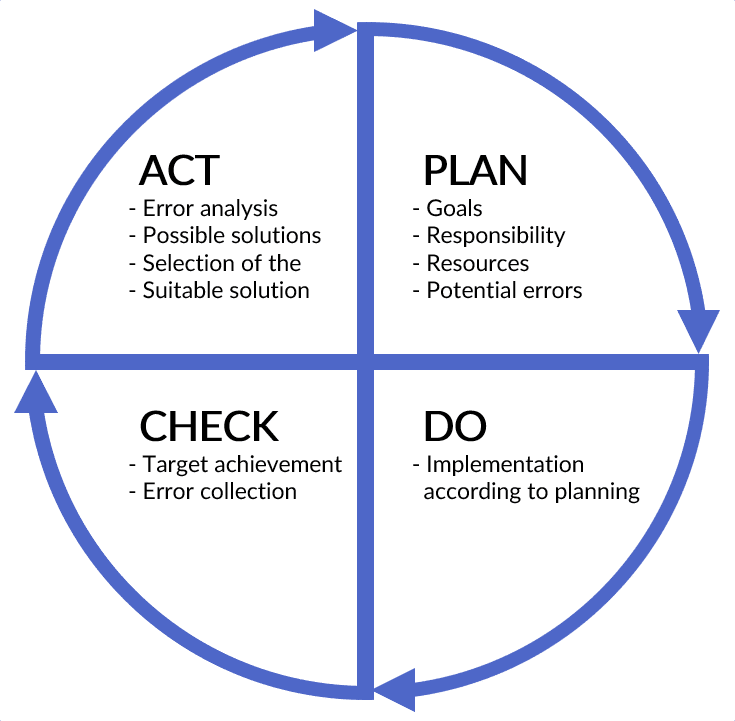CIP - Continuous Improvement Process
CIP, Continuous Improvement Process or Kaizen (from the Japanese: KAI = change; ZEN = the good), refers to the replacement of the good with the better. The basis for this is continuous improvement measures that are implemented in small steps to improve process, product and service quality, as required, for example, by ISO9001 in quality management. In Kaizen, all employees are involved (especially at the executive level) and trained to recognize problems and develop their own detailed solutions (small steps), which are then implemented in a timely manner. This leads to a cultural change in the company. Kaizen builds on standardized processes, order and cleanliness, visual management and an existing company suggestion scheme, and develops its own company “attitude to life” or “working atmosphere” from these elements through their consistent and lasting application.
What are the prerequisites for CIP?
- The entire management must be committed to the CIP and fully support the employees in its implementation
- Short and comprehensible decision-making processes must create the possibility to implement CIP suggestions promptly (sense of achievement for the employee)
- Kaizen requires ideas and knowledge of employees, who will only cooperate if they have a job security guarantee
- Simple key figures (comprehensible for the MA) should be used for the formulation of goals and the evaluation of results
- There must be an awareness among stakeholders that the current situation has weaknesses (quality, service, cost)
What are the prerequisites for CIP?
Step 1: Preparatory measures
- Implementation of the 5S
- Create standardized work instructions for all operations
- Visual representation of the current situation through display panels in production
- Introduction of a company suggestion scheme with incentives for the best ideas in order to address and sensitize employees across the board to the issue of improvements without pressure
Step 2: Pilot phase
- Start with smaller, voluntary “expert teams” that are trained extensively (social skills, PDCA, 7A…) and develop and implement some Kaizen pilot projects that are presented in the company.
Step 3: Extending Kaizen to the Enterprise
- Training of other employees (department by department) in methodological and social skills
- Team members of the first expert team each lead a smaller kaizen group
- Weekly kaizen group meetings where suggestions are discussed and tried out together on the production floor
- Progress boards show the current group projects and results and serve on the one hand as direct feedback of good work (motivation), on the other hand they stimulate competition between groups
- Regular trainings and events (company rents a bowling alley every Tuesday, productivity party when a certain value is reached) in order to maintain knowledge and motivation of employees permanently

CIP with PDCA
A perceived problem can be systematically addressed and solved by means of the PDCA cycle (Deming wheel), waste is eliminated. The procedure is carried out in four steps:
- Plan: Quantitative description of the initial situation First, the situation is described – if possible in data – and the problems evident in it are derived. Based on the data, the target state and packages of measures are developed and agreed, i.e. who has to do what and by when.
- Do: The solution is implemented on a trial basis
- Check: After implementation, a target/actual comparison is made to determine whether the new procedure is better than the previous one.
- Act: The new approach becomes generally binding
What are the problems with CIP in practice?
Kaizen is introduced in many companies and established in the short term. After a short time, however, increasing mobilization and motivation problems arise, leading to discontinuation. The main reason for this is the decreasing commitment of both management and employees. The causes are:
- Lack of backing/support from top management
- Lack of exchange of experience between kaizen groups
- No structured and visible Kaizen approach in the company (no visual representation)
- Lack of target agreements
- Organizational changes not followed by the kaizen groups
- No continuation of regular method training
- No temporary time off for kaizen measures (extra time for kaizen)
- Lack of recognition for achievements
- Hierarchical organizational structures prevent “normal employees” from contributing their ideas
In order to maintain Kaizen permanently, it is recommended to implement Kamishibai. Kamishibai contains on a map all elements of a location in the plant (island, line, warehouse), i.e. a short mention of all essential process steps there. The Kamishibai map is hung up directly at the location. The manager now has to audit every 2/4/8/12 weeks (depending on the design) the processes that are on the map and deal with the location himself and can thus initiate improvements. The results are presented in a management room for Kamishibai. Not filling in and taking out a card is thus noticed in production and management. New cards are then distributed.
